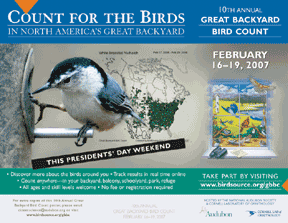Help Put Our Neighborhood Birds on the Map
Count in your own backyard this weekend
by Dotty Holcomb Doherty
A downy woodpecker pecks at the seed-studded suet in a feeder hanging by my kitchen window. Just inches away, her perch slowly twirls to reveal the dusty brush of bristles at the base of her bill, her glittery dark eyes and the skunk-like white stripe running soft between her spotted black wings. Earlier, walking home from the library, I noticed a mockingbird — a species not seen at my feeders — zipping out of our front trees to sit on a traffic sign, tail alert and eyes darting.
A wide diversity of birds shares my tiny wooded plot, and even more flock to the nearby park and beach. I look forward to February’s Presidents’ Day weekend, when for the first time in years, I will be home to tally these birds in the Great Backyard Bird Count.
Now in its 10th year, the Great Backyard Bird Count, sponsored by the Cornell Lab of Ornithology and National Audubon Society, gives everyone a chance to put their neighborhood birds on the map.
“The Great Backyard Bird Count is a community celebration of birds, birding and nature,” said Janis Dickinson, director of Citizen Science at the Cornell Lab of Ornithology. “We often fail to notice how rich our surroundings are, but counting birds, even for just 15 minutes, is not only educational. It can provide a lasting source of enjoyment, turning a daily walk into a treasure hunt.”
Counting is easy. Between February 16 and 19, count the birds you see for a minimum of 15 minutes. You may count in as many places and for as many days as you like, so long as you keep each checklist separate. Record the highest number of birds of each species seen at any one time. Send your data to the count’s website: www.birdsource.org/gbbc
In 2006, backyard birders submitted 60,000 checklists recording 7.5 million birds of 623 species. Maryland tallied 155 different species in 1,363 checklists, 236 of which came from Anne Arundel and Calvert counties.
Audubon and the Cornell Lab of Ornithology encourage more people to Count for the Record in this 10th anniversary year, hoping for the biggest turnout ever. Each checklist adds a crucial piece to the ever-changing puzzle.
“By submitting their counts online, birdwatchers can quickly see how the dots they put on the map form new patterns that tell new stories about the birds that share the world in which we live, including our own backyards and parks,” says Paul Green, Audubon’s director of Citizen Science.
Chesapeake Country lies in a transitional area. Many northern waterfowl species winter here, while most migrating songbirds continue south. Are warming temperatures changing these patterns? Data from the last several years point to an apparent trend: Many birds, including robins, are wintering farther north. Maryland saw a large increase in robins last year; how many are in your yard? The more data we submit, the clearer these trends become, better focusing conservation efforts.
All ages and abilities are welcome. For help with identification, go to the count’s website. Here you will find a list of all the birds you are likely to see in your area in February. Click on a bird for its complete information: appearance, sounds, habits and similar species.
Birders can submit their photos of February birds to an online gallery or compete in a prize drawing for everyone who submits a checklist, a photo contest and the coveted Checklist Champ title for towns, states and provinces with the highest participation.
I count birds at my feeder each week for Project Feeder Watch and on my woodland walks and river paddles for eBird, both programs sponsored by Cornell. This year, I can add the Great Backyard Bird Count.
My 16-year-old daughter Helen calls to me from the driveway. “Mom! There’s a pileated out here.” I look up where she points, following the distinctive sound of this prehistoric-looking woodpecker’s slow drumming: Peck. Peck-peck. Peck. I silently make a wish, hoping this large, red-crested bird will return to my yard in mid-February.
“Stick around,” I whisper.